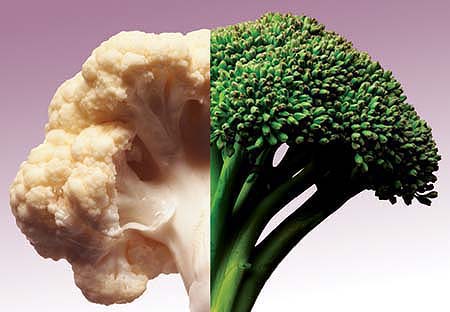All Issues
Challenges and opportunities for horticultural biotechnology
Publication Information
California Agriculture 58(2):68-71.
Published April 01, 2004
PDF | Citation | Permissions
Full text
The term “biotechnology” encompasses a wide array of techniques through which humans employ biological processes to provide useful products. In the broadest sense, it includes the use of yeast in brewing and baking, and the breeding of plants and animals. More recently, the term has come to mean the collection of techniques that allow the direct manipulation of specific pieces of genetic material within and between organisms. Although there are many applications of biotechnology in crop and livestock improvement that do not include gene transfer, it is the ability to transfer genes among different species that has attracted the most controversy.
The application of biotechnology to crops has transformed the landscape of American agriculture for soybeans, corn, cotton and canola by providing genetic resistance to herbicides and insects. Since the first large-scale introduction in 1996, the global area planted to transgenic crops has grown to 167 million acres in 2003, of which 106 million acres (63%) were in the United States. In 2003, biotech varieties providing herbicide or insect resistance represented 81% of soybeans, 73% of cotton and 40% of corn grown in the United States.
It is evident from these adoption rates that the traits provided through biotechnology are benefiting some farmers. However, biotechnology has had limited commercial success to date in horticultural crops, including fruits, vegetables, flowers and landscape plants — the crops that comprise 60% of California's agricultural production value. Even though the first transgenic crop to reach the market was the Flavr Savr tomato, and sweet corn, potato, squash and papaya varieties engineered to resist insects and viruses have been approved for commercial use and marketed, papaya is the only horticultural crop for which transgenic varieties have achieved a significant market share (about 70% of the Hawaiian crop shipped to the continental United States is transgenic).
This issue of California Agriculture examines the challenges and opportunities for commercialization of biotech horticultural crops. A number of technical, economic, regulatory and market factors have combined to create hurdles for the utilization of biotechnology in horticultural crops, which are more diverse than field crops. Horticulture includes hundreds of distinct plants, the majority of which are grown on small acreages and which individually represent relatively small market values. Even the vegetable crops with the largest gross revenues, such as lettuce and tomatoes, are minor crops compared to major field crops like corn or soybeans. Their limited acreage makes it more difficult to recover the research and development costs of any new technology specific to these crops. Because of the limited size of the individual markets, the costs of gaining access to patented genetic-engineering methods and meeting the regulatory requirements for testing and registration of biotech crops represent substantial economic hurdles for horticultural products.
At the same time, consumer concerns and the related reluctance of food processors and marketers to accept new biotech commodities are delaying the introduction of horticultural products already developed. These barriers are exacerbated by the globalization of fresh produce markets and the growing dominance of large supermarket chains, as exporters must meet diverse regulatory requirements in different countries and specific standards set by multinational food marketers. Due to the disappointing past commercial results and current market outlook, many horticultural seed and nursery companies are reducing their investments in genetic engineering research. However, they are continuing to apply biotechnology to support traditional breeding activities.
In March 2002, a workshop was convened in Monterey, Calif. Its purpose was to bring together the spectrum of disciplines and industries involved in horticulture — including development, production, processing and marketing — to assess the current situation with respect to horticultural applications of biotechnology and identify avenues for future progress. Experts considered potential biotech products that would be desired by growers and consumers; identified hurdles limiting the application of biotechnology in horticultural crops; discussed priorities for future research and development; and explored the implications for public and regulatory policy. At the conclusion of the workshop, selected participants were asked to develop the papers that are presented in this issue of California Agriculture.
The themes explored here parallel those of the workshop, beginning with an assessment of the current status of horticultural biotechnology in terms of both the economic “state of the market” (page 80) and the technical “state of the art” (page 89). Sidebars to these articles explore specific issues with respect to changes in the market environment for fresh produce (page 82) and current and potential biotech products (pages 84, 92, 94, 96). The key issue of consumer acceptance of biotech crops is analyzed (page 99), with specific cases illustrating the difficulties in accurately assessing consumer preferences (pages 100,103). These articles demonstrate the potential benefits that biotechnology could provide to horticultural crops as well as the significant challenges to bring them to the marketplace. Prominent among the latter are regulations specific to transgenic crops that significantly increase the cost of development and commercialization (page 106). Meanwhile, with commercialization stymied in the United States, China, already a major and rapidly growing competitor of California in Asian horticultural markets, is moving forward with the application of biotechnology to improve the efficiency of production and the quality of its horticultural products (page 112).
Public institutions have traditionally played a major research role in horticultural crops, and this is also true of horticultural biotechnology. How should they respond to the declining private interest in biotechnology research? It may be appropriate to increase research support in cases where there is a compelling public interest, such as the development of nutritionally enhanced food products or when a devastating disease threatens a horticultural industry and a biotech-based solution is the most viable option for developing resistant varieties. However, public institutions generally do not have access to the full range of enabling technologies and trait genes, nor the resources to satisfy the regulatory and stewardship requirements needed to develop a commercial biotech variety, making public-private partnerships an attractive avenue for development (page 116).
Cauliflower and broccoli are derived from the same genetic ancestor, Brassica oleracea, but were developed over many years into individual and very different vegetables through selection and breeding. Biotech-nology can make this process more precise and less time-consuming.
New licensing structures for enabling technologies developed in universities and public research institutions may be particularly helpful for small-revenue crops as well as for developing countries (page 120). The Public Intellectual Property Resource for Agriculture (PIPRA) soon to be headquartered at UC Davis represents a significant development in this area (page 127).
Public research agendas can also be targeted toward developing new methods for lowering intellectual-property and regulatory barriers and providing access to modern biotechnologies for specialty crops. In addition, the government can play a role in encouraging private research and development and facilitating the adoption of new technologies. For instance, the U.S. Department of Agriculture's IR-4 program, which assists in the registration of agricultural chemicals for specialty crops, could be broadened to support the registration of biotech varieties (page 110).
While recognizing that there are alternative viewpoints, we do not question the potential value that biotechnology can bring to horticulture. The acreage of biotech crops grown worldwide continues to increase annually, and growers clearly recognize the benefits of reduced pesticide use and conservation tillage enabled by these first-generation products. Regulation and monitoring are needed to ensure that novel traits are assessed for both food and environmental safety prior to commercialization. However, such prudent precautions should not be so restrictive as to present insurmountable barriers to the commercialization of horticultural products that could provide significant benefits to producers and consumers as well as to the environment. We believe that the responsible application of biotechnology is compatible with and has much to contribute to agricultural and environmental sustainability while helping to maintain the competitiveness of U.S. horticultural products in the global marketplace. With that view in mind, we have summarized some of the key research and policy objectives that emerged from the Monterey Workshop and that are elaborated in the articles of this special issue ( see box, page 70 ).
Objectives for horticultural biotechnology
A set of key research and policy objectives were developed out of discussions at the Workshop on Biotechnology for Horticultural Crops in Monterey.
Research
New technologies and products
-
Develop efficient transformation technologies for many specialty crops.
-
Develop promoters for tissue-, development-, disease-and environment-specific gene
expression.
-
Develop targeted gene-insertion techniques to control the site of integration.
-
Develop a Generally Recognized As Safe (GRAS) set of methodologies that would not
require characterization and registration of individual genetic-insertion “events.”
-
Develop products with clear and significant benefits for consumers.
Regulatory process
-
Develop methods to quantify potential risks associated with individual species-trait
combinations.
-
Test product safety, potential for gene transfer to noncrop organisms, and the biological
and environmental consequences of any such transfers.
-
Quantify full economic costs of regulatory policies.
-
Compare potential benefits and risks of biotech products to current practices.
Marketing and adoption
-
Continue market research to determine consumer attitudes and how these change over
time.
-
Model and measure the roles of food processors and marketers in affecting farmer adoption
and market acceptance of biotech products.
-
Project the market potential of specific trait-crop combinations.
-
Project consumer responses to altered nutritional content and associated labeling.
Policy
New technologies and products
-
Develop a collaborative public-technology and intellectual-property resource.
-
Develop technology and trait-licensing packages to enable public and entrepreneurial
commercial-iza-tion of specialty and subsistence crops.
-
Target increased public research funding toward the application of genomics and biotechnology
in horticultural crops, including methods that support traditional breeding.
Regulatory process
-
Examine current regulations in light of accumulated experience and reduce redundant
regulatory requirements when appropriate and justified.
-
Replace regulation based on a single gene-insertion “event” with a more general approval
of speciestrait combinations.
-
Create or extend governmental programs to assist small-market crops in data collection
required for the regulatory process.
Marketing and adoption
-
Establish identity-preservation and channeling programs to allow the coexistence of
diverse market segments.
-
Establish practical thresholds for adventitious (accidental) presence of approved
biotech products to facilitate international trade.
-
Provide documented scientific information on the relative risks and benefits of biotechnology
for horticultural crops.
Develop efficient transformation technologies for many specialty crops.
Develop promoters for tissue-, development-, disease-and environment-specific gene expression.
Develop targeted gene-insertion techniques to control the site of integration.
Develop a Generally Recognized As Safe (GRAS) set of methodologies that would not require characterization and registration of individual genetic-insertion “events.”
Develop products with clear and significant benefits for consumers.
Develop methods to quantify potential risks associated with individual species-trait combinations.
Test product safety, potential for gene transfer to noncrop organisms, and the biological and environmental consequences of any such transfers.
Quantify full economic costs of regulatory policies.
Compare potential benefits and risks of biotech products to current practices.
Continue market research to determine consumer attitudes and how these change over time.
Model and measure the roles of food processors and marketers in affecting farmer adoption and market acceptance of biotech products.
Project the market potential of specific trait-crop combinations.
Project consumer responses to altered nutritional content and associated labeling.
Develop a collaborative public-technology and intellectual-property resource.
Develop technology and trait-licensing packages to enable public and entrepreneurial commercial-iza-tion of specialty and subsistence crops.
Target increased public research funding toward the application of genomics and biotechnology in horticultural crops, including methods that support traditional breeding.
Examine current regulations in light of accumulated experience and reduce redundant regulatory requirements when appropriate and justified.
Replace regulation based on a single gene-insertion “event” with a more general approval of speciestrait combinations.
Create or extend governmental programs to assist small-market crops in data collection required for the regulatory process.
Establish identity-preservation and channeling programs to allow the coexistence of diverse market segments.
Establish practical thresholds for adventitious (accidental) presence of approved biotech products to facilitate international trade.
Provide documented scientific information on the relative risks and benefits of biotechnology for horticultural crops.
Glossary: BIOTECHNOLOGY
Agricultural technology: technology based on the domestication of wild plants to create crops. Humans invented agriculture approximately 10,000 years ago; primitive crop cultivars, also known as land races, were adapted to local growing conditions and preferences. Today's crops are the result of thousands of years of gradual selection.
Agronomic/field/row crops: agricultural crops grown on larger acreages for food or nonfood products, including grains, alfalfa, field corn, oils, soybeans, canola (rapeseed) and cotton.
Allele: single transformation event which contains the genetic trait of interest and expresses the desired phenotype.
Biotech foods: those produced with genetically engineered crops or ingredients.
Biotechnology: the use of living organisms or their vital processes or components to provide new products. In modern usage, biotechnology refers to genetically engineered (GE) crop plants.
Chromosome: the organized structure containing DNA and genetic information.
Conventional/traditional breeding: genetic modification of plants through sexual crosses using parents selected for desirable traits.
Cultivar: a particular cultivated variety of a domesticated plant species.
Deregulation: the governmental approval of a biotech cultivar for commercial release in the United States without further regulatory restrictions on its production or utilization.
DNA (deoxyribonucleic acid): carrier of primary genetic information in most organisms.
Expression: the manifestation of a characteristic specified by a gene; also refers to the production of proteins by a genetically engineered organism.
Gene: the basic unit of informational inheritance consisting of a sequence of DNA and generally occupying a specific position within the genome.
Genetically engineered (GE)/genetically modified organisms (GMO): organisms with new combinations of genetic material. DNA from another organism is modified in the laboratory and transformed into an organism in which the specific sequence does not naturally occur.
Genetics: the science of the transmission of characteristics between generations.
Genotype: the total of all genetic information contained in an organism.
Germplasm: genetically distinct variants of a species that can represent a valuable natural resource of plant diversity.
Graft: a plant bud, shoot or scion that is inserted into the stem or stock of another plant, where it continues to grow.
Horticultural crops: fruits, vegetables, sweet corn, nuts, ornamental and landscape plants that are generally grown on smaller acreages than agronomic/field crops.
Hybrid: the offspring of a specific cross between two genetically distinct (usually inbred) parents
Intellectual property rights (IPR): the legal rights to the use of the results from research, invention, and other creative activity, such as the rights provided by patents or copyrights.
Marker (genetic): a distinguishing feature that can be used to identify a particular gene location on a chromosome.
Phenotype: appearance or other characteristics of an organism, which result from interactions of its genetic constitution with the environment.
Protein: a molecule composed of a chain of many amino acids that acquires a particular folded shape due to the amino acid sequence. Both the sequence of the amino acids and the pattern of folding are involved in the specific function of the protein.
Recombinant DNA: DNA formed external to a living cell by joining DNA from two or more different sources in the laboratory.
Sexual crosses: the transfer of pollen from one plant to the pistil of another closely related plant to result in seeds that carry traits derived from both parents.
Tissue culture (in plant biotechnology): the process of regeneration of a plant from single cells, isolated embryos or small bits of plant tissue on liquid or solid media.
Trait: a phenotypic characteristic associated with the expression of a single gene.
Transformation: the process of introducing a cloned gene into an organism.
Transgenic: an organism containing genetic material from other species introduced via the process of transformation.









